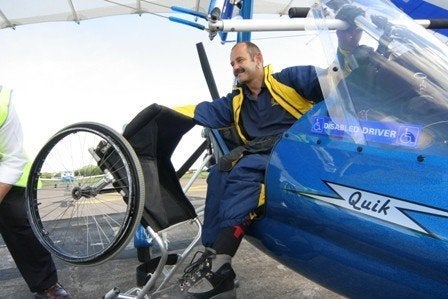
In 1969, we stepped foot on the moon and, according to some, reached the pinnacle of progress in the aerospace sciences. Yet our earliest and most basic aeronautical dream, to fly like the birds, using only our own muscle power, remained elusive. In the decade that followed however, this would all change as a series of high profile aviation challenges were conquered one by one, including an epic human-powered flight across the English Channel in 1979.
One of those challenges, however, has remained completely untouched: the Sikorsky Prize, awarded for the first flight of a human-powered helicopter. In 1980, the American Helicopter Society established the Sikorsky Prize, creating a challenge that would push the limits of helicopter engineering far beyond the status quo. The challenge requires that a helicopter, powered solely by the strength of the pilot, reach an altitude of 3 meters, and stay airborne for at least 1 minute. In addition, the helicopter must remain within a 10m x 10m square, which requires a certain level of controllability. In 2009, Sikorsky Aircraft Corporation increased the value of the prize to $250,000, making it the third largest prize in the history of aviation.
So why has such a large prize remained unclaimed for more than 30 years? Well it's certainly not for a lack of trying. Since the inception of the prize, countless teams worldwide have taken on the challenge and three aircraft have managed to briefly lift of the ground. In 1994 the Japanese-built Yuri managed 19 seconds of flight at a height of 0.2 meters, but to reach the 3-meter altitude requirement to win the prize has been a much more difficult challenge.
The problem, of course, is that the human body can produce, at best, about 1 horsepower for a one-minute flight. This is about half the power that it takes to run a good hair dryer! Is it even possible to build a helicopter that can lift so much weight on so little power? It turns out that it is, but the aircraft will have to be absolutely enormous, possibly even bigger than 30 meters across. As far as the aerodynamics are concerned, it's more efficient to push very lightly on a large mass of air than to push hard on a very small mass of air. So bigger is better. But bigger means heavier, and with human-powered aircraft, weight is the biggest enemy. A viable Sikorsky Prize helicopter would have to be in the range of 100 pounds or less. For something the size of a Boeing 737, this is a pretty steep challenge!
Fortunately, there's one trick that we have at our disposal, and that's called ground effect. The closer you fly to the ground, the less power is required of the helicopter. Effectively the air that you are pushing down is trapped beneath the helicopter, providing a cushion for you to ride on, similar to a hovercraft. Of course the folks at the American Helicopter Society considered this, which is why they imposed the 3-meter requirement on the prize. For a typical human-powered helicopter it could take almost twice as much power to fly at 3 meters as it would to fly a few inches off the ground.
The truth is, this is a very difficult challenge, and to win it will require a level of refinement that represents a significant step in the aerospace sciences. The development of a successful Sikorsky Prize helicopter will very likely result in the creation of new design methodologies, innovative construction methods, and research findings that have impact far beyond the narrow goal of the prize. Just as the first human-powered aircraft prizes in the 1970's led directly to the creation of the first solar-powered airplanes, the Sikorsky Prize could spur spin offs in a variety of green technology research fields; and that's likely what Sikorsky Aircraft Corporation was hoping for when they increased the value of the prize in 2009.
So far it's working. Since 2009, several new high-profile teams have taken on the challenge, bringing to the table a wealth of experience in the design of helicopters, lightweight structures, and innovative human-powered vehicles. A team at the University of Maryland, as well as NTS Works in California, have now set their sights on the prize. New to the competition is my own team, AeroVelo, made up primarily of students and graduates from the University of Toronto. The core members of the team have been working together for six years on various projects, including what became the world's first human-powered flapping-wing aircraft in 2010, and a high-speed streamlined bicycle that reached 116.9 km/hr on a level road in Nevada. We hope to bring a new set of talents to the challenge and experience that will set us apart from the rest. Of course this is history in the making, and only time will tell.